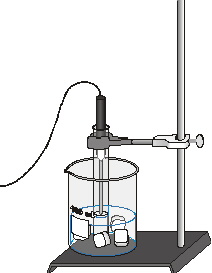Freezing and Melting of Water
Freezing temperature, the temperature at which a substance turns from liquid to solid, and melting temperature, the temperature at which a substance turns from a solid to a liquid, are characteristic physical properties. In this experiment, the cooling and warming behavior of a familiar substance, water, will be investigated. By examining graphs of the data, the freezing and melting temperatures of water will be determined and compared.
OBJECTIVES
In this experiment, you will
• Collect temperature data during the freezing and melting of water.
• Analyze graphs to determine the freezing and melting temperatures of water.
• Determine the relationship between the freezing and melting temperatures of water.

Figure 1
MATERIALS
LabQuest |
10 mL graduated cylinder |
LabQuest App |
test tube |
Temperature Probe |
salt |
ring stand |
ice |
utility clamp |
water |
400 mL beaker |
|
PROCEDURE
Part I Freezing
1. Put about 100 mL of water and 6 ice cubes into a 400 mL beaker.
2. Put 5 mL of water into a test tube and use a utility clamp to fasten the test tube to a ring stand. The test tube should be situated above the water bath. Place the Temperature Probe into the water inside the test tube.
3. Connect the Temperature Probe to LabQuest and choose New from the File menu. If you have an older sensor that does not auto-ID, manually set up the sensor.
4. On the Meter screen, tap Rate. Change the data-collection rate to 0.2 samples/second (interval of 5 seconds/sample) and the data-collection length to 900 seconds. Select OK.
5. When everything is ready, start data collection. Lower the test tube into the ice-water bath.
6. Soon after lowering the test tube, add 5 spoons of salt to the beaker and stir with a stirring rod. Continue to stir the ice-water bath throughout the remainder of Part I.
7. Slightly, but continuously, move the Temperature Probe during the first 10 minutes of Part I. Be careful to keep the probe in, and not above, the ice as it forms. When 10 minutes have gone by, stop moving the probe and allow it to freeze into the ice. Add more ice cubes to the beaker as the original ice cubes get smaller.
8. Data collection will stop after 15 minutes. Keep the test tube submerged in the ice-water bath until Step 11.
9. Analyze the flat part of the graph to determine the freezing temperature of water.
a. Identify a flat portion of the graph that represents freezing. Tap and drag your stylus across the flat portion of the graph to select the region that represents freezing.
b. Choose Statistics from the Analyze menu.
c. Record the mean (average) temperature. This is your value for the freezing temperature of water.
10. Store the data from the first run by tapping the File Cabinet icon.
Part II Melting
11. Start data collection, then raise the test tube and fasten it in a position above the ice-water bath. Do not move the Temperature Probe during Part II.
12. Dispose of the ice water as directed by your teacher. Obtain 250 mL of warm tap water in the beaker. When 12 minutes have passed, lower the test tube and its contents into this warm-water bath.
13. Data collection will stop after 15 minutes. Analyze the flat part of the graph to determine the melting temperature of water.
a. Identify a flat portion of the graph that represents melting. Tap and drag your stylus across the flat portion of the graph to select the region that represents melting.
b. Choose Statistics from the Analyze menu.
c. Record the mean (average) temperature. This is your value for the freezing temperature of water.
14. A good way to compare the freezing and melting curves is to view both sets of data on one graph. Tap Run 2 and select All Runs. Both runs will now be displayed on the same graph axes.
15. (optional) Print a graph of temperature vs. time (with two curves displayed). On the paper copy, label each curve as “freezing of water” or “melting of ice.”
DATA TABLE
Freezing temperature of water |
°C |
Melting temperature of water |
°C |
Processing the data
1. What happened to the water temperature during freezing? During melting?
2. According to your data and graph, what is the freezing temperature of water? The melting temperature? Express your answers to the nearest 0.1">°C.
3. How does the freezing temperature of water compare to its melting temperature?
4. Tell if the kinetic energy of the water in the test tube increases, decreases, or remains the same in each of these time segments during the experiment when:
a. the temperature is changing at the beginning and end of Part I.
b. the temperature remains constant in Part I.
c. the temperature is changing at the beginning and end of Part II.
d. the temperature remains constant in Part II.
5. In those parts of Question 4 in which there was no kinetic energy change, tell if potential energy increased or decreased.